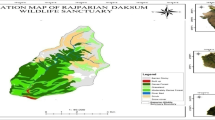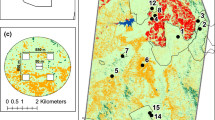Abstract
The parameters referring to landscape structure are essential in any evaluation for conservation because of the relationship that exists between the landscape structure and the ecological processes. This paper presents a study of the relationships between landscape structure and species diversity distribution (estimated in terms of richness of birds, amphibians, reptiles and butterflies) in the region of Madrid, Spain. The results show that the response of species richness to landscape heterogeneity varies depending on the group of species considered. For birds and lepidopterans, the most important factor affecting the distribution of richness of species is landscape heterogeneity, while other factors, such as the specific composition of land use, play a secondary role at this scale. On the other hand, richness of amphibians and reptiles is more closely related to the abundance of certain land-use types. The study highlights the importance of heterogeneity in Mediterranean landscapes as a criterion for landscape planning and for definition of management directives in order to maintain biodiversity.
Similar content being viewed by others
References
Andrén, H. 1994. Effects of habitat fragmentation on birds and mammals in landscapes with different proportions of suitable habitat: a review. Oikos 71: 355–366.
Andrewartha, H.G. 1961. Introduction to the study of animal populations. University of Chicago Press, Chicago, IL, USA.
Antrop, M. 1997. The concept of traditional landscapes as a base for landscape evaluation and planning. The example of Flanders Region. Landscape and Urban Planning 38: 105–117.
Ayala Carcerdo, F.J. (Dir.) 1988. Atlas geocientífico del medio natural de la Comunidad de Madrid. Instituto Geológico y Minero de España, Madrid, Spain.
Baker, W.L. and Cai, Y.1992. The r.le programs for multiescale analysis of landscape structure using the GRASS geographical information system. Landscape Ecology 7: 291–302.
Baz, A. and García-Boyero, A. 1995. The effects of forest fragmentation on butterfly communities in central Spain. Journal of Biogeography 22: 129–140.
Berg, A. 1997. Diversity and abundance of birds in relation to forest fragmentation, habitat quality and heterogeneity. Bird Study 44: 355–366.
Böhning-Gaese, H. 1997. Determinants of avian species richness at different spatial scales. Journal of Biogeography 24: 49–60.
Burel, F. and Baudry, J. 1995. Species biodiversity in changing agricultural landscapes: a case study in the Pays d'Auge, France. Agriculture, Ecosystems and Environment 55: 193–200.
Cowling, R.M., Rundel, P.W., Lamont, B.B., Arroyo, M.K. and Arianoutsou, M. 1996. Plant diversity in medterranean-climate regions. Trends in Ecology and Evolution 11: 362–366.
de León, A. 1989. Caracterización agroclimática de la provincia de Madrid. Ministerio de Agricultura, Pesca y Alimentación, Madrid.
de Pablo, C.L., Martín de Agar, P. and Gómez sal, A. 1988. Descriptive capacity and indicative value of territorial variables in ecological cartography. Landscape Ecology 1: 203–211.
Edenius, L. and Sjölberg, K. 1997. Distribution of birds in natural landscape mosaics of old-growth forests in northern Sweden: relations to habitat area and landscape context. Ecography 20: 425–431.
Estrada, A., Coates-Estrada, R. 1997. Anthropogenic landscape changes and avian diversity at Los Tuxtlas, iMexico. Biodiversity and Conservation 6: 19–43.
Farina, A. 1997. Landscape structure and breeding bird distribution in a sub-Mediterranan ago-ecosystem. Landscape Ecology 12: 365–378.
Forman, R.T.T. 1995. Land Mosaics. Cambridge University Press, Cambridge, UK.
Forman, R.T.T. 1995. Some general principles of landscape and regional ecology. Landscape Ecology 10: 133–142.
Franklin, J.F. 1993. Preserving biodiversity: species, ecosystems, or landscapes?. Ecological Applications 3: 202–205.
García-Paris, M, Martín, C, Dorda, J. y Esteban, M. 1989. Atlas provisional de los anfibios y reptiles de Madrid. Revista Española de Herpetología 3: 237–257.
Gómez de AizpÚrua, C. 1997. Mariposas diurnas deMadrid. Consejería de Medio Ambiente y Desarrollo Regional, Comunidad de Madrid, Madrid, Spain.
González Bernáldez, F. 1991. Diversidad biológica, gestión de ecosistemas y nuevas políticas agrarias. In Diversidad Biológica / Biological Diversity. Fundación Ramón Areces – ADENA/WWF – SCOPE. pp. 23–31. Edited by F.D. Pineda et al. Madrid, Spain.
González Bernáldez, F. 1992. Ecological consequences of the abandonment of traditional land use systems in central Spain. Options Mediterranéennes Ser. Sem. 15: 23–29.
Grossi, J.L., Chevanier, L., Delcros, P. and Brun, J.J. 1995. Effects of landscape structure on vegetation and some animal groups after agricultural abandonment. Landscape and Urban Planning 31: 291–301.
Harrison, S. and Fahrig, L. 1995. Landscape pattern and population conservation. In Mosaic Landscapes and Ecological Processes. Edited by L. Hanson, L. Fahrig and G. Merrian. IALE Studies in Landscape Ecology, Chapman and Hall.
Hawksworth, D.L. and Katlin-Arroyo, M.T. 1995. Magnitude and distribution of biodiversity. In Global biodiversity assessment. Edited by V.H. Heywood. United Nations Environment Programme. Cambridge University Press, Cambridge, UK.
Hulshoff, R.M. 1995.Landscape indices describing a Dutch landscape. Landscape Ecology 10: 101–111.
Huston, M.A. 1994. Biological Diversity. The coexistence of species on changing landscapes. Cambridge University Press, Cambridge, UK.
Jongman, R.H.G. 1996. Ecological consequences of land use change in Europe. ECNC publication series on Man and Nature vol. 2, European Centre for Nature Conservation, Tilburg, Amsterdam, The Netherlands.
Keith, T.H., Urban, D.L. and Milne, B.T. 1997. Detecting critical scales in fragmented landscapes. Conservation Ecology 1(1): 4. (http://www.consecol.org)
Kerr, J.T. and Packer, L. 1997. Habitat heterogeneity as a determinant of mammal species richness in high-energy regions. Nature 385: 252–254.
Legendre, L. and Legendre, P. 1982. Numerical Ecology. Developments in Environmental Modelling, 3. Elsevier Scientific Publishing Company, Amsterdam, The Netherlands.
Levin, S.A. 1992. The problem or pattern and scale in ecology. Ecology 73(6): 1943–1967.
Lubchenco, J., Olson, A.M., Brubaker, L.B., Carpenter, S.R., Holland, M.M., Hubell, S.P., Levin, S.A., MacMahon, J.A., Matson, P.A., Melillo, J.M., Money, H.A., Peterson, C.H., Pulliam, H.R., Real, L.A., Regal, P.J. and Risser, P.G. 1991. The sustainable biosphere initiative: an ecological research agenda. Ecology 72: 371–412.
Marrugan, A.E. 1989. La diversidad ecológica y su medición. Ediciones Vedrà, Barcelona, Spain.
Martín de Agar, P., De Pablo, C.T. and Pineda, F.D. 1995. Mapping the ecological structure of a territory: a case study in Madrid (Central Spain). Environmental Management 19: 345–357.
Mazerolle, M.J. and Villard, M.A. 1999. Patch characteristics and landscape context as predictors of species presence and abundance: a review. Ecosience 6: 117–124.
Meentemeyer, V. and Box, E.O. 1987. Scale Effects in Landscape Studies. In Landscape Heterogeneity and Distrubance. pp. 15-34. Edited by M.G. Turner. Springer-Verlag, New York, NY, USA.
Miller, J.N., Brooks, R.P. and Croonquist, M.J. 1997. Effects of landscape patterns on biotic communities. Landscape Ecology 12: 137–153.
Naveh, Z. 1994. From biodiversity to ecodiversity: a landscape-ecology approach to conservation and restoration. Restoration Ecology 2: 180–189.
O'Neill, R.V., Krummel, J.R., Gardner, R.H., Sugihara, G., Jackson, D.L., Milne, B.T., Turner, M.G., Zygmunt, B., Christensen, S.W., Dale, V.H. and Graham, R.L.1988. Indices of landscape pattern. Landscape Ecology 1: 153–162.
Orive, L. (Coord.). 1985. Mapa de las formaciones vegetales y usos actuales del suelo de Madrid. Memoria. Comunidad de Madrid, Consejería de Agricultura y Ganadería, Madrid, Spain.
Parish, T., Lakhani, K.H. and Sparks, T.H. 1995. Modelling the relationship between bird population variables and hedgerow and other field margin attributes. II. Abundance of individual species and of groups of similar species. Journal of Applied Ecology 32: 362–371.
Pineda, F.D. 1992. Conservation of the biological diversity and traditional systems of land use on the Mediterranean. Ethnobotanical Congress '92. Córdoba, Spain.
Rescia, A.J., Schmitz, M.F., Martin de Agar, P., de Pablo, C.L. Atauri, J.A. and Pineda, F.D. 1994. Influence of landscape complexity and land management on woody plant diversity in northern Spain. Journal of Vegetation Science 5: 505–516.
Ritters, K.H., O'Neill, R.V., Hunsaker, C.T., Wickham, D.H., Yankee, D.H., Timmins, S.P., Jones, K.B. and Jackson, B.L. 1995. A factor analysis of landscape pattern and structure metrics. Landscape Ecology 10: 23–39.
Ruiz, J.P. 1990. Development of mediterranean agriculture: an ecological approach. Landscape and Urban Planning 18: 211–220.
Santos, T. and Tellería, J.L. 1997. Efectos de la fragmentación sobre las aves insectívoras forestales en dos localidades europeas. Ardeola 44: 113–117.
Scheiner S.M. and Rey-Benayas, J.M. 1994. Global patterns of plant diversity. Evolutionary ecology 8: 331–347.
SEO 1994. Atlas de las aves nidificantes en Madrid. Agencia de Medio Ambiente. SEO/BirdLife, Madrid, Spain.
Shmida, A. and Wilson, M.V. 1985. Biological determinants of species diversity. Journal of Biogeography 12: 1–20.
StatSoft. 1992. CSS: Statistica. StatSoft Inc., Tulsa, OK, USA.
Tellería, J.L. 1987 Biogeografía de la avifauna nidificante en la España Central. Ardeola 34: 145–166.
Turmer, M.G., O'Neill, R.V., Conley, M.R. and Humphries, H.C. 1991. Pattern and scale: statistics for landscape ecology. In Quantitative methods in landscape ecology. Edited by M.G. Turner and R.H. Gardner, Springer-Verlag, New York, NY, USA.
Turner, M.G. and Ruscher, C.L. 1988. Changes in landscape patterns in Georgia, USA, Landscape Ecology 1(4): 241–251.
Turner, M.G., Dale, V.H. and Gardner, R.H. 1989. Predicting across scales: Theory development and testing. Landscape Ecology 3: 245–252.
Turner. M.G. 1990. Spatial and temporal analysis of landscape patterns, Landscape Ecology 4: 21–30.
Urban, D.L., O'Neill, V. and Shugart Jr., H.H. 1987. Landscape ecology: a hierarchical perspective can help scientists understand spatial patterns. BioScience 37: 119–127.
Wiens, J.A. and Milne, B.T. 1989. Scaling of ‘landscapes’, or, landscape ecology from a beetle's perspective. Landscape Ecology 3: 87–96.
Wiens, J.A., Stenseth, N.C., Van Horne, B. and Ims, R.A. 1993. Ecological mechanisms and landscape ecology. Oikos 66: 369–380.
Wright, D.A. 1983. Species-energy theory, an extension of species-area theory. Oikos 41: 456–507.
Zar, J.H. 1984. Biostatistical Analysis. Second Edition. Prentice Hall International Editions. New Jersey, USA.
Zonneveld, I.S. and Forman, R.T.T. (Eds) 1990. Changing landscapes: an ecological perspective. Springer Verlag, New York, NY, USA.
Author information
Authors and Affiliations
Rights and permissions
About this article
Cite this article
Atauri, J.A., de Lucio, J.V. The role of landscape structure in species richness distribution of birds, amphibians, reptiles and lepidopterans in Mediterranean landscapes. Landscape Ecology 16, 147–159 (2001). https://doi.org/10.1023/A:1011115921050
Issue Date:
DOI: https://doi.org/10.1023/A:1011115921050




